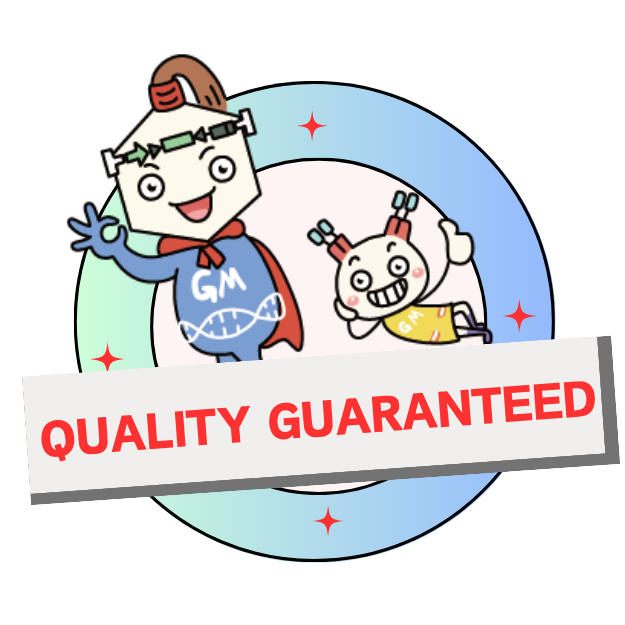Gibberellin antibody/antigen (BSA/OVA/KLH conjugated hapten) GMP-SMT-165
anti-Gibberellin antibody and Carrier-coupled antigen/immunogen (hapten-carrier conjugates)
Product information
Size: 1mg | 10mg | 100mg
| Catalog No. | Description | US $ Price (per mg) | First Order Discount | First Order Discount Price |
|---|---|---|---|---|
| GMP-SMT-165-Ag-1 | BSA-Gibberellin | 756 | ||
| GMP-SMT-165-Ag-2 | OVA-Gibberellin | 756 | ||
| GMP-SMT-165-Ab-1 | Anti-Gibberellin mouse monoclonal antibody | 1953 | 20% | 1562.4 |
| GMP-SMT-165-Ab-2 | Anti-Gibberellin human monoclonal antibody | 1953 | 20% | 1562.4 |
| GMP-SMT-165-Ag-3 | BSA-Gibberellin | 756 | ||
| GMP-SMT-165-Ab-3 | Anti-Gibberellin mouse monoclonal antibody | 1953 | 20% | 1562.4 |
Shipping Costs: $360–$760
Antibodies: $360 Antigens: $760 (Elevated cost due to antigen heterogeneity, post-translational modifications, structural complexity, and specialized handling.)
Product Description
BSA-Gibberellin
| Cat No. of Products | GMP-SMT-165-Ag-1, GMP-SMT-165-Ag-3 |
| Product Name | BSA-Gibberellin |
| Expression platform | |
| Target | Gibberellin |
| Bioactivity validation | Competitive immunoassay validation (Competitive ELISA) with hapten-carrier conjugates and anti-Hapten antibody; |
| Products description | Competitive immunoassay-validated hapten-carrier conjugates BSA-Gibberellin with anti-Hapten antibody. The hapten hapten-carrier conjugates BSA-Gibberellin had been validated with our anti-Hapten antibody Anti-Gibberellin mouse monoclonal antibody via competitive ELISA test. |
| Application |
ELISA tests and other immunoassays; Lateral flow immunoassay (LFIA); LTIA; Immunonephelometry; Time-resolved Fluorescence Immunoassay (TRFIA); |
| Formulation & Reconstitution | PBS liquid / Lyophilized from GM's Protein Stability Buffer2 (PSB2,Confidential Ingredients) or PBS (pH7.4); For PSB2, reconstituted with 0.9% sodium chloride; For PBS, reconstituted with ddH2O. |
| Storage | Store at -20℃ to -80℃ under sterile conditions. Avoid repeated freeze-thaw cycles. |
OVA-Gibberellin
| Cat No. of Products | GMP-SMT-165-Ag-2 |
| Product Name | OVA-Gibberellin |
| Expression platform | |
| Target | Gibberellin |
| Bioactivity validation | Competitive immunoassay validation (Competitive ELISA) with hapten-carrier conjugates and anti-Hapten antibody; |
| Products description | Competitive immunoassay-validated hapten-carrier conjugates OVA-Gibberellin with anti-Hapten antibody. The hapten hapten-carrier conjugates OVA-Gibberellin had been validated with our anti-Hapten antibody Anti-Gibberellin mouse monoclonal antibody via competitive ELISA test. |
| Application |
ELISA tests and other immunoassays; Lateral flow immunoassay (LFIA); LTIA; Immunonephelometry; Time-resolved Fluorescence Immunoassay (TRFIA); |
| Formulation & Reconstitution | PBS liquid / Lyophilized from GM's Protein Stability Buffer2 (PSB2,Confidential Ingredients) or PBS (pH7.4); For PSB2, reconstituted with 0.9% sodium chloride; For PBS, reconstituted with ddH2O. |
| Storage | Store at -20℃ to -80℃ under sterile conditions. Avoid repeated freeze-thaw cycles. |
Anti-Gibberellin mouse monoclonal antibody
| Cat No. of Products | GMP-SMT-165-Ab-1, GMP-SMT-165-Ab-3 |
| Product Name | Anti-Gibberellin mouse monoclonal antibody |
| Expression platform | |
| Target | Gibberellin |
| Bioactivity validation | Competitive immunoassay validation (Competitive ELISA) with hapten-carrier conjugates and anti-Hapten antibody; Lateral flow immunoassay (LFIA); |
| ELISA IC50 (ppb) | 0.9-1 |
| Products description | The anti-Hapten antibody against hapten Gibberellin had been validated with our hapten hapten-carrier conjugates BSA-Gibberellin via competitive ELISA test. |
| Host of Antibody | Mouse IgG |
| Application |
ELISA tests and other immunoassays; Lateral flow immunoassay (LFIA); LTIA; Immunonephelometry; Time-resolved Fluorescence Immunoassay (TRFIA); |
| Formulation & Reconstitution | Lyophilized from GM's Protein Stability Buffer2 (PSB2,Confidential Ingredients) or PBS (pH7.4); For PSB2, reconstituted with 0.9% sodium chloride; For PBS, reconstituted with ddH2O. |
| Storage | Store at -20℃ to -80℃ under sterile conditions. Avoid repeated freeze-thaw cycles. |
Anti-Gibberellin human monoclonal antibody
| Cat No. of Products | GMP-SMT-165-Ab-2 |
| Product Name | Anti-Gibberellin human monoclonal antibody |
| Expression platform | |
| Target | Gibberellin |
| Bioactivity validation | Competitive immunoassay validation (Competitive ELISA) with hapten-carrier conjugates and anti-Hapten antibody; Lateral flow immunoassay (LFIA); |
| ELISA IC50 (ppb) | 0.9-1 |
| Products description | The anti-Hapten antibody against hapten Gibberellin had been validated with our hapten hapten-carrier conjugates BSA-Gibberellin via competitive ELISA test. |
| Host of Antibody | Human IgG1 |
| Application |
ELISA tests and other immunoassays; Lateral flow immunoassay (LFIA); LTIA; Immunonephelometry; Time-resolved Fluorescence Immunoassay (TRFIA); |
| Formulation & Reconstitution | Lyophilized from GM's Protein Stability Buffer2 (PSB2,Confidential Ingredients) or PBS (pH7.4); For PSB2, reconstituted with 0.9% sodium chloride; For PBS, reconstituted with ddH2O. |
| Storage | Store at -20℃ to -80℃ under sterile conditions. Avoid repeated freeze-thaw cycles. |
Reference
Validation Data
Click to get more Data / Case study about the product.
About GDU

GDU helps global diagnostic partners in high quality of raw material discovery, development, and application. GDU believes in Protein&antibody Innovation for more reliable diagnostic solutions.






 Go to Biologic toxin (Mycotoxins/Enterotoxins/endotoxins/exotoxins) diagnostics products collection
>>
Go to Biologic toxin (Mycotoxins/Enterotoxins/endotoxins/exotoxins) diagnostics products collection
>>
Comments
No comments yet.